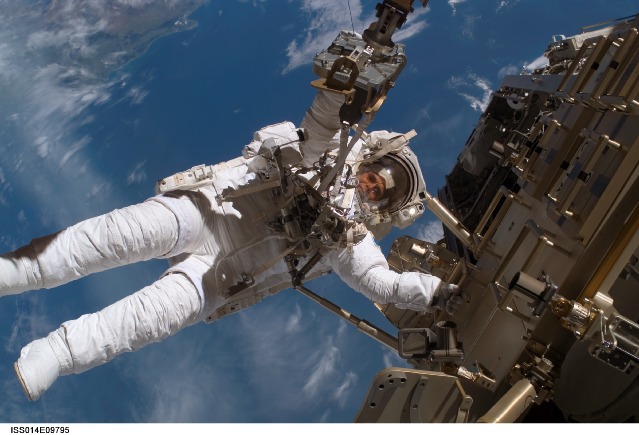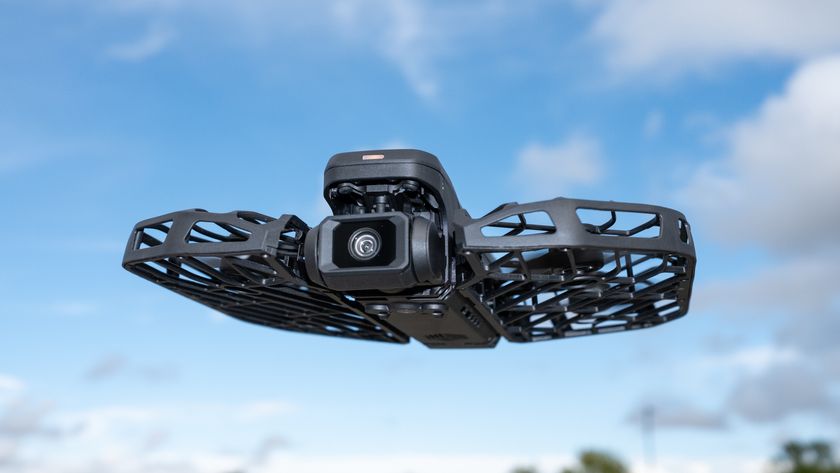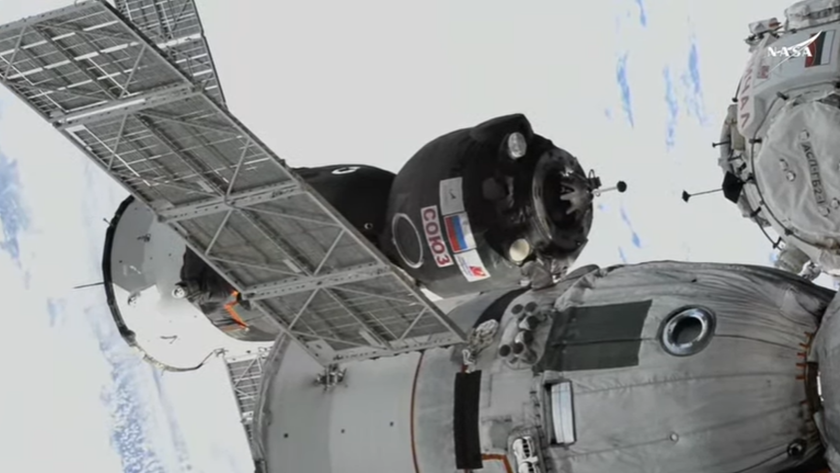Cyborg Astronaut Space Race Heats Up

Cyborgs — human beingsmerged with machines — are a staple of science fiction.
Star Wars' Darth Vader, StarTrek's Borg, and the Cybermen of Dr. Whoare variations on this theme — and it's no coincidence they're all"bad guys." Cyborgs symbolize one of ourgreatest fears: that over time, we will become so enmeshed in our technologythat we lose our humanity.
Thereal-life application of cyborg science is far fromhorrifying. Medical technology has developed implantable heart pacemakers,insulin pumps, hearing aids, and even computer chips for the brain to treatdepression and Parkinson's disease. In that sense, we are already on the pathto becoming cyborgs.
Transhumanists believe that thedevelopment of such technology will lead one day to "Humanversion 2.0" — an upgrade of the human body that not onlyeliminates many of the problems that plague us, but improves upon the basichuman design. For instance, some transhumanistsenvision a day when the human brain will be re-wired with computer chips,allowing us to think, learn and communicate with unprecedented speed andaccuracy.
There's anethical leap between using technology to help people overcome disabilities, andusing it to "improve" healthy humans. The 1972 science fiction novel,Cyborg by Martin Caidin,which was turned into the popular TV show The Six-Million-Dollar Man,bridges the gap by creating a cyborg superman as alife-saving measure. The title character was a NASA test pilot who sufferedtraumatic injuries when his plane crashed. His legs, left arm, and an eye werereplaced with bionic parts, giving him superior speed, strength and vision.
Martin Caidin's novel may have been inspired by discussions takingplace within the space community around that time. NASA had considered the possibilityof engineering humans, not to create super heroes, but to help us travel tothe other planets and the stars beyond.
Buildinga Better Astronaut
Get the Space.com Newsletter
Breaking space news, the latest updates on rocket launches, skywatching events and more!
Without aspacesuit, a person could only survive for about 90 seconds in the vacuum ofspace. Not only does space lack breathable oxygen, but the vacuum pressurewould cause the blood in your veins to bubble and expand. Space is so cold— minus 270 C (minus 454 F) — you would be frozen solid in shortorder. Radiation is another mode of destruction — space contains highenergy gamma and X-rays, as well as the lower energy but still harmful UVlight.
In 1960,Manfred Clynes and Nathan Kline published an essay inAstronautics titled "Cyborgs inSpace." Comparing man in space to a fish out of water, they noted thateven if you could bring everything you need on your space explorations,"the bubble all too easily bursts."
However, ifthe human body were altered to adaptto the conditions of space, astronauts would be free to explore theuniverse without limitation.
"Solvingthe many technical problems involved in manned space flight by adapting man tohis environment, rather than vice versa, will not only mark a significant stepforward in man's scientific progress, but may well provide a new and largerdimension for man's spirit as well," the authors write.
The Clynes & Kline paper coined the term "cyborg," and NASA followed up on their suggestions,commissioning a study on the topic. "The CyborgStudy: Engineering Man for Space" was released in 1963, and it reviewedthe possibility of organ replacement, as well as how drugs and hibernationcould be used to make space travel less stressful. The report concluded thatreplacing the heart, lungs and kidneys — the organsmost stressed by space travel — was not feasible with thetechnology available at the time.
Inconsidering how hibernation and drugs could be used to deal with physical andpsychological stress, the study's scope included master control over anastronaut's brain and body. The current academic discussion of cyborg studies embraces an even broader view of "cyborg" to mean the general impact of technology onour lives.
"Youcould say that cyborgization started with furs andfire, and certainly with glasses and dentures," says James Hughes, medicalethicist at Trinity College in Hartford, Connecticut.
Hughes isthe author of the book, Citizen Cyborg: WhyDemocratic Societies Must Respond to the Redesigned Human of the Future.Hughes says we should acknowledge that we are already living in the Age of the Cyborg. This process has been gradual but steady, and asmedical technology advances, more people will opt for the advantages of thelatest innovations — so long as they're convinced the benefitsoutweigh the risks. Hughes points to LASIK eye surgery as one example.
"Icontinue to wear glasses, and one of the reasons is that I want to see moreevidence that LASIK really works in ways it's supposed to," says Hughes."I haven't been convinced yet. I think many people will have that reactionto sticking hardware in their brain. Your laptop is obsolescent almost the dayyou buy it, so why would you want to stick something in your brain when you'dneed surgery in order to replace it?"
Today asurgical brain implant such as the one to treat Parkinson's disease is a remedyof last resort. But if the technology was more benign, with an easier way forpeople to download the latest upgrade, such implants might become more common.
"Youmight imagine that you could swallow a nanotech pill, and nanobotswould unfold in your gut and migrate their way past the blood-brain barrier andfind where they're supposed to go," says Hughes. "You couldtheoretically give them instructions, and say, 'It's time for you guys to flushout because I want the next upgrade.' They all die and go out in your urine,and then you take another pill."
KevinWarwick, of the Cybernetic Intelligence Research Group at the University ofReading in England, isn't waiting for the invention of medical nanobots. He had a computer device surgically implanted inhis arm in two separate experiments.
As recountedin his book, I, Cyborg, the first experimentinvolved a radio frequency identification (RFID) chipenclosed in a glass tube. The tube was inserted under the skin in his arm, andthe RFID chip communicated with a computer.
In thesecond, more invasive experiment, spikes on a silicon microarray were poundeddirectly into the median nerve in his left arm. This 100 electrode arrayallowed his nervous system to receive signals from a computer. Warwick and hiscolleagues performed various experiments, including operating a wheelchair,sending signals over the Internet, and human-to-human communication (via a wireimplanted in his wife's arm). Warwick's nerve implant was removed after severalmonths, after the planned experiments were completed.
Warwick saysthat other than tingly feelings in his fingers due to nerve fiber regeneration,he didn't experience any unusual physical effects from the implant. Before theexperiment, he had wondered if his brain would even respond to the electricalsignals. If it did accept the signals, would it be able to translate them? Orwould the unusual new data overwhelm his brain? Luckily his brain was able tomake sense of the input, but when he talks about his experiment withneurosurgeons or other doctors, they often express concern.
"Varioussurgeons have said I could've had serious problems with putting electricalcurrent into my nervous system that was going up to my brain," saysWarwick. "Some of the signals were quite strong, because we were trying toforce the brain to not ignore them. My brain could have decided to go onholiday, or I could have gone crazy. It's probably just as well I didn't knowcompletely the things that could've gone wrong."
Despite suchrisks, Warwick sees huge potential in developing implantable computer chips.He's currently trying to improve the Parkinson's brain implant to betterpredict the onset of tremors. He also thinks computer chips could be used tobridge broken nerve fibers, bringing movement back to paralyzed body parts, butthis concept remains purely speculative.
"For aserious break or lesion, how much you can bring that into play is a bigquestion," says Warwick. "We can't see why people haven't tried [touse computer chips to stimulate damaged nerves] yet, because it seems anobvious thing to try."
A lot of cyborg technology remains either speculative or a longway from practical implementation. The development of artificial organs is nottoo far advanced from what was available when NASA commissioned its cyborg study.
Althoughartificial hearts and lungs are now more compact and better at the jobs theywere designed for, they are used mainly as temporary replacements to helppatients survive until appropriate donor organs become available.
Artificialkidneys — dialysis machines — have posed the greatest challenge,partly due to the need to filter large amounts of fluid. In the 60s, artificialkidneys were the size of a refrigerator. Today, the smallest devices are stillnot implantable, but a recent prototype can be worn as an extremely bulkyutility belt. Artificial bones, blood, skin, eyes, and even noses are now allbeing developed, and each could conceivably help man cope with the conditionsof space. So long as the resulting entity still had a human brain, it could beconsidered a cyborg rather than an android (a robotthat looks like a human).
However,NASA isn't devoting any thought these days on how to build a better astronaut.Their Human Research Program instead focuses on ways that drugs, exercise,better spacesuits and radiation shielding can mitigate the effects of the spaceenvironment on human health. There is more discussion in the space community onhow to alter entire planets to suit humans — a process called "terraforming" — than there is on changing man tosuit space.
One reasonNASA has little interest in cyborgs may be due totheir focus on bringing astronauts back home safely. Humans altered for life inspace might not fare too well on Earth. Permanent adaptation is an issue forfuture Mars colonists as well, since over time the weaker gravity could resultin thinner bones. While some have advocated "one-way trips," withpeople living out the remainder of their lives on Mars, current NASA plansenvision stays lasting only 500 days.
Warwick isdisappointed by NASA's lack of research into the possibilities of a cyber-astronautcorps.
"They'retaking the easier option as far as public opinion is concerned," saysWarwick. "It's certainly not the most exciting one as far as research isconcerned, and hence [not the field] with the biggest potential. So it's ashame."
But Hughessays that astronauts, along with all the other people on Earth, will inevitablyend up with cyborg upgrades.
"Ithink that we're all going to be engineering ourselves for various things inthis century," says Hughes. "Certainly the rigors of space travel aregoing to require extensive bioengineering, unless we come up with someincredible material science. So I assume that, just like the kinds of thingswe'll all be doing on Earth, astronauts will avail themselves of those things."
VisitSPACE.com SATURDAY for Part 2 of this report on the rise of cyborgastronauts and robotic space exploration.
Join our Space Forums to keep talking space on the latest missions, night sky and more! And if you have a news tip, correction or comment, let us know at: community@space.com.
Leslie Mullen is an award-winning science photojournalist who has produced TV, radio, podcasts, live stage shows, and web features. Her work has been featured by NASA, PBS, National Geographic Channel, and other media outlets. Recently, Leslie has worked as writer, producer and host of the NASA/JPL podcast, "On a Mission," which was part of JPL's 2019 Emmy Award for "Outstanding Original Interactive Program." The podcast was awarded the gold medal for best technology podcast at the 2019 New York Festivals Radio Awards, and was a 2019 Webby Award honoree for best science and education podcast.












